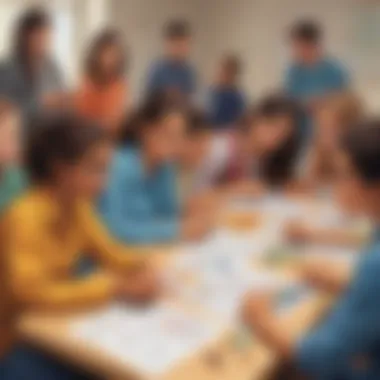Mastering the Art of Counting up to 100: A Comprehensive Guide for Elementary School Children


Creative Activities
In the realm of numerical mastery, engaging children in creative activities can exponentially enhance their understanding of counting to 100. From crafting unique counting tools to visually representing numbers, these activities serve as experiential learning tools for young learners. Children can create their own number lines using colorful craft materials, helping them visualize the sequence from 1 to 100. Additionally, crafting number flashcards can reinforce their ability to recognize and recall numbers accurately. These step-by-step guides ensure that children can actively participate in the creation process, promoting a sense of ownership over their learning journey. The significant educational value lies in promoting tactile and visual learning experiences, which are crucial for solidifying numerical concepts at an early age.
Fun Quizzes
To infuse an element of fun and challenge into the learning process, incorporating interactive quizzes focused on counting to 100 can be both entertaining and instructive. Quiz topics can range from basic number recognition to more complex sequences and patterns. By incorporating various question types such as multiple-choice, fill-in-the-blank, and sequencing, children are exposed to different ways of approaching numerical problems, fostering critical thinking skills. Moreover, these quizzes serve as a means of knowledge reinforcement by providing immediate feedback on correct and incorrect answers. Through consistent engagement with these quizzes on platforms like ElemFun, children can develop a deeper understanding of numerical concepts while enjoying the thrill of interactive learning.
Fact-Based Articles
Supplementing practical activities and quizzes, fact-based articles offer a wealth of information on counting to 100 and related mathematical concepts. The diverse topics covered in these articles range from the historical significance of numbers to real-world applications of counting in daily life. Presented in an engaging and easy-to-understand manner, these articles cater to young readers by breaking down complex ideas into digestible nuggets of knowledge. Moreover, additional resources provided within the articles offer avenues for further exploration and learning, whether through interactive online games or offline activities. By immersing children in informative yet captivating content, fact-based articles effectively complement hands-on experiences and quizzes, contributing to a holistic understanding of counting to 100.
Introduction
To embark on the journey of mastering the art of counting up to 100 is to lay a robust foundation for numerical proficiency. In this article, we delve deep into the intricacies of counting, catering to the developmental needs of elementary school children aged 5 to 12. Understanding the basics and building a strong foundation are pivotal steps in this educational odyssey.
Understanding the Basics
Learning the Numbers to
Learning the numbers 1 to 10 serves as the initial stepping stone towards numerical mastery. It is the fundamental building block upon which higher numerical concepts are constructed. By grasping the essence of these ten digits, learners develop a solid numerical grounding essential for advanced calculations and problem-solving. The simplicity and universality of these numbers make them a cornerstone in the mathematical education of young minds.
Exploring Place Value Concepts
Exploring place value concepts elucidates the significance of the position of digits within a number. This exploration aids students in comprehending the relative value each digit holds based on its placement. Understanding place value not only enhances numerical fluency but also lays the groundwork for tackling complex mathematical operations with confidence. It fosters a deeper appreciation for the structure and logic inherently embedded in numbers.
Building a Strong Foundation


The Role of Counting in Early Education
The role of counting in early education cannot be understated, as it forms the bedrock of mathematical literacy. Counting instills in young learners a sense of order, sequence, and magnitude crucial for navigating the numerical realm. It nurtures patience, attention to detail, and critical thinking, all essential skills for academic success. By mastering the art of counting, children develop a strong mathematical identity from the outset of their educational journey.
Enhancing Numerical Fluency
Enhancing numerical fluency goes beyond rote memorization; it cultivates a deep understanding of numbers and their relationships. Numerical fluency empowers students to manipulate numbers effortlessly, allowing for quick mental calculations and logical deductions. It sharpens analytical skills, fosters problem-solving capabilities, and boosts overall mathematical confidence. By honing numerical fluency, students gain a versatile tool for navigating a myriad of mathematical challenges.
Core Strategies
Counting by tens forms a fundamental aspect in mastering the art of counting up to 100 in this comprehensive guide. By focusing on multiples of 10 and practicing skip counting, learners enhance their numerical fluency and grasp on number patterns. These strategies lay a robust foundation for understanding the sequencing of numbers and improve overall counting abilities.
Counting by Tens
Mastering Multiples of 10: Understanding how to group and count by tens simplifies the process of counting to 100 significantly. By recognizing patterns in tens and identifying multiples efficiently, learners streamline their counting skills, facilitating quicker calculations and a deeper comprehension of numerical relationships.
Practicing Skip Counting: Skip counting involves jumping by specific intervals, such as 2s, 5s, or 10s. This method enhances mental math abilities, strengthens number recognition, and cultivates a structured approach to counting. By engaging in skip counting exercises, learners develop a spatial understanding of numbers and hone their ability to count rapidly.
Utilizing Visual Aids
Incorporating Number Charts: Number charts provide a visual representation of numbers, aiding in conceptualizing numerical sequences and patterns. By utilizing number charts, learners reinforce their understanding of counting by tens, enhancing their ability to identify multiples and comprehend number relationships.
Engaging with Number Lines: Number lines offer a dynamic visual tool to facilitate counting by tens and visualize numerical progressions. By interacting with number lines, learners develop a tactile sense of number magnitude, improve their number sense, and refine their ability to count sequentially. Engaging with number lines fosters a hands-on approach to counting, promoting a deeper understanding of numbers and their placement on a scale.
Advancing Skills
In the journey of mastering the art of counting to 100, advancing skills play a pivotal role. As young learners progress in their numerical proficiency, the section on advancing skills introduces them to the complexities of counting in various sequences. By focusing on concepts like exploring odd and even numbers and introducing counting patterns, students enhance their ability to identify number patterns and relationships. This prepares them for more advanced mathematical concepts and fosters a deeper understanding of numerical sequences. Emphasizing these advanced skills sets a strong foundation for building higher-level arithmetic proficiency.
Counting in Different Sequences


Exploring Odd and Even Numbers
Delving into the realm of exploring odd and even numbers within the context of counting to 100 provides young learners with a fundamental understanding of number parity. By differentiating between odd and even numbers, students learn to recognize patterns that extend beyond simple numerical values. This exploration not only sharpens their counting skills but also enhances their critical thinking and problem-solving abilities. Understanding the distinct characteristics of odd and even numbers aids in laying the groundwork for more complex mathematical operations, making it a crucial aspect of the learning journey towards mastering counting to 100.
Introducing Counting Patterns
Introducing counting patterns offers a structured approach to numerical sequences, allowing students to identify and apply repetitive number sequences. By recognizing and predicting patterns, learners develop a deeper comprehension of numerical relationships. This section encourages students to think analytically and strategically when approaching counting tasks. The unique feature of counting patterns lies in its ability to enhance memory retention and cognitive processing, facilitating a more efficient and accurate counting process. While exploring counting patterns, students develop essential skills in recognizing regularities within numerical series, paving the way for a more profound grasp of mathematical concepts.
Practical Applications
Counting Objects and Groups
The practical application of counting objects and groups introduces students to real-world scenarios that enhance their counting abilities. By engaging in hands-on activities involving physical objects and grouped items, learners practice counting in context. This hands-on approach fosters a multi-sensory learning experience, promoting tactile and visual understanding of numerical relationships. Recognizing the key characteristic of counting objects and groups as a tangible and interactive method reinforces numerical fluency, making counting to 100 more relatable and engaging for young learners. Although requiring physical materials, this method offers a dynamic and immersive learning environment that solidifies counting skills in a practical setting.
Understanding Number Relationships
Understanding number relationships is crucial in consolidating the mastery of counting to 100. By exploring the interconnectedness of numbers and their relative values, students develop a deeper appreciation for mathematical concepts. This section highlights the significance of identifying how numbers relate to one another, offering insights into numerical operations and sequences. Recognizing the balance between numerical components enhances students' problem-solving skills and logical reasoning. The unique feature of understanding number relationships lies in its ability to bridge numerical concepts, fostering a holistic understanding of numerical frameworks. By grasping these intricate connections, young learners strengthen their foundational knowledge, paving the way for advanced numerical fluency.
Enhancing Proficiency
In the journey of mastering the art of counting to 100, enhancing proficiency stands as a crucial element. By delving deeper into this topic, learners can refine their counting skills and numerical fluency. Understanding the importance of enhancing proficiency involves honing the ability to count accurately and efficiently. For elementary school children aged 5 to 12, this skill is fundamental in developing a strong mathematical foundation for future learning endeavors. The benefits of focusing on enhancing proficiency include boosting confidence in handling numbers, improving problem-solving capabilities, and laying a solid groundwork for advanced mathematical concepts. Considerations about enhancing proficiency revolve around consistent practice, engaging learning methods, and tailored approaches to cater to individual learning styles.
Interactive Learning Tools
Exploring Counting Games
Exploring counting games introduces a dynamic and interactive approach to reinforce counting skills. These games offer engaging challenges that make learning counting concepts enjoyable and effective. Key characteristics of exploring counting games include thematic scenarios, interactive feedback, and progressive difficulty levels. This aspect contributes significantly to the article's goal by providing a fun and educational avenue for children to practice counting. The unique feature of exploring counting games lies in their ability to merge entertainment with learning seamlessly. While these games are a popular choice for enhancing counting skills, some potential disadvantages may include over-reliance on technology and limited real-world application.
Interactive Online Resources


Interactive online resources play a vital role in extending learning beyond traditional classroom settings. These resources offer a vast collection of counting exercises, interactive challenges, and educational videos to support numerical proficiency. The key characteristic of interactive online resources lies in their accessibility and diverse content catering to different learning preferences. They are a beneficial choice for this article as they provide additional practice opportunities and reinforce counting concepts in an engaging manner. The unique feature of interactive online resources is their adaptability to individual progress levels, ensuring personalized learning experiences. While highly advantageous in supplementing learning, potential drawbacks may include distractions from other online content and the need for internet connectivity.
Real-world Practice
Counting Scavenger Hunts
Integrating counting scavenger hunts into learning activities promotes practical application of counting skills in real-world scenarios. These hunts involve searching for and counting specific objects based on clues or instructions. The key characteristic of counting scavenger hunts is their hands-on and interactive nature, making learning enjoyable and memorable. They contribute immensely to the article's goal by enhancing observational and numerical skills outside the classroom environment. The unique feature of counting scavenger hunts is their ability to instill critical thinking and teamwork skills alongside counting proficiency. While highly beneficial for practical learning, potential disadvantages may include limited scalability for large groups and the need for adequate supervision.
Mathematical Storytelling
Mathematical storytelling intertwines mathematical concepts with engaging narratives to make learning more relatable and captivating. This aspect contributes to developing a deeper understanding of counting principles through storytelling elements. The key characteristic of mathematical storytelling is its ability to contextualize abstract mathematical ideas into real-life situations, fostering a holistic approach to learning. It is a beneficial choice for this article as it marries creativity with numeracy, enhancing children's comprehension and retention of counting concepts. The unique feature of mathematical storytelling lies in its cross-curricular potential, connecting mathematics with language arts for a well-rounded educational experience. While highly engaging, potential disadvantages may include time constraints for elaborate storytelling sessions and varying levels of storytelling appeal among learners.
Mastering and Beyond
In this comprehensive guide on mastering counting to 100, the section of Mastery and Beyond plays a crucial role in advancing numerical proficiency. As children progress through basic concepts and core strategies, reaching the Mastery and Beyond section signifies a higher level of skill acquisition and mathematical understanding. This section delves into advanced techniques and challenges that push learners to achieve counting fluency beyond the fundamental counting principles.
Achieving Counting Fluency
Speed Counting Drills
Speed Counting Drills are an essential component in honing counting fluency. These drills focus on rapid calculation and accurate enumeration, enhancing a child's ability to swiftly count numbers up to 100. The key characteristic of Speed Counting Drills lies in their emphasis on quick mental processing and retention of numerical sequences. This mode of practice aids in building mental agility and sharpening counting skills effectively, making it a popular choice for reinforcing numerical fluency within the context of this article. One unique feature of Speed Counting Drills is their ability to increase computational speed while maintaining accuracy levels. However, the drawback could be potential mental fatigue from continuous rapid calculations.
Challenge Exercises
Challenge Exercises are designed to push counting abilities to higher levels, fostering a deeper understanding of numerical patterns and sequences. By presenting complex counting tasks and thought-provoking problems, Challenge Exercises prompt children to apply their counting knowledge in innovative ways. The key characteristic of Challenge Exercises is their capacity to spark critical thinking and problem-solving skills, offering a stimulating challenge for young learners seeking to enhance their numerical proficiency. Their unique feature lies in creating an environment where children can explore unconventional counting methods and develop resilience in tackling challenging mathematical problems. A significant advantage of Challenge Exercises is the capability to cultivate perseverance and a growth mindset towards overcoming numerical hurdles, although some learners may find these exercises initially daunting.
Exploring Higher Numbers
Introducing Hundreds and Thousands
Introducing Hundreds and Thousands marks a pivotal point in the progression towards mastering counting beyond 100. This aspect contributes to broadening a child's numerical horizon by introducing larger units of measurement and expanding the scope of counting capabilities. The key characteristic of Introducing Hundreds and Thousands lies in facilitating comprehension of place value and enabling children to grasp the concept of multiplying by hundreds and thousands. This introduction is a beneficial choice for the article as it paves the way for transitioning from double-digit counts to triple and quadruple-digit counting, allowing learners to visualize numerical scales more expansively. The unique feature of Introducing Hundreds and Thousands is its capability to lay a robust foundation for dealing with larger numerical values, providing a seamless pathway for children to grasp advanced counting concepts. However, the disadvantage could be potential confusion arising from the sudden increase in numerical magnitude.
Mastering Extended Counting
Mastering Extended Counting takes numerical proficiency to the next level by delving into intricate counting patterns and calculations beyond standard hundreds and thousands. This aspect contributes significantly to refining a child's ability to handle complex numerical operations and sequential counting beyond conventional limits. The key characteristic of Mastering Extended Counting is its emphasis on developing a deep understanding of number systems and fostering higher-order thinking skills essential for advanced mathematics. This choice is beneficial for the article as it challenges learners to think critically and apply counting principles in diverse scenarios, providing a solid framework for tackling mathematical challenges that transcend conventional counting domains. The unique feature of Mastering Extended Counting is the opportunity it offers for children to explore abstract numerical concepts and develop analytical reasoning skills, although some may find the increased complexity initially overwhelming.







